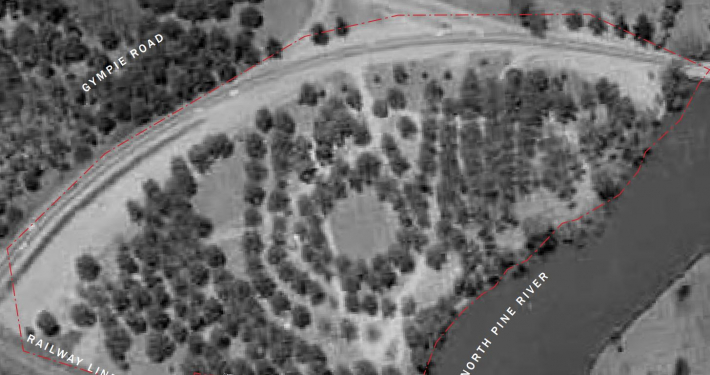Conservation of Wyllie Park Roadside Rest Area – Petrie
Summary
While the circumstances surrounding unique concentric circles of Slash Pine trees planted at Petrie’s Wyllie Park will likely forever remain a mystery, the opportunity to help revive one of Moreton Bay’s most-loved public reserves has been a rewarding journey.
Australian Heritage Specialists delved into the rich history of the heritage-listed roadside rest area on Gympie Road, pictured below in 1969, as part of suite of studies commissioned by Moreton Bay Regional Council prior to its restoration.
Our work was recognised statewide, with the resulting Heritage master Plan winning the Cultural Heritage category of the Australian Institute of Landscape Architects 2020 Queensland awards.
The challenge
The challenge was to ensure the heritage values of the park were retained during a $800,000 upgrade with the areas forming part of the Petrie Mill Priority Development Area (PDA).
As part of the adjacent redevelopment of the former Petrie Mill into the region’s first university, Moreton Bay Regional Council undertook a range of improvements to the access road and carparking, renewed footpaths, new barbecues as well as the planting of additional trees.
When many of the early trees thought to have been planted in the 1940s, time had not been kind to the once idyllic park, with many of them failing and needing to be removed.
Once a popular camping spot for the growing number for travellers on their way north when Old Gympie Road was the highway to the North Coast from Brisbane, the Council’s aim was to revive the park’s character so that local and interstate travellers could once again stop in and learn about Petrie’s history as well as enjoy the beauty before them on the banks of the North Pine River.
How we helped
The history of Wyllie Park stretches back way beyond the arrival of Europeans and was known to be a meeting point for Indigenous people.
Bought by Alexander Wyllie in 1883 as part of the Riverleigh property, the reserve became prominent following the opening of the A.J. Wyllie Bridge in 1937, which realigned Gympie Road.
It is unclear if the land was acquired by Main Roads to establish a rest reserve for motorists, or if it grew organically by those travelling between Brisbane and the northern coast area.
One of its most intriguing aspects is the planting of concentric circles of Slash Pine trees, clearly evident in images from 50 to 60 years ago.
Unfortunately Pinus elliottii is one of the most short-lived species of pine. By 2015, many of the trees had reached ‘senescence’ or had already died.
AHS prepared a Conservation Management Plan (CMP) for the park to protect and manage its heritage values in line with the Queensland Heritage Act 1992, Australia ICOMOS Burra Charter, 2013 (Burra Charter), and the Queensland Department of Environment and Science (DES) Conservation Management Plans Guideline.
Based on the findings of the CMP, we also worked in collaboration with Moreton Bay Regional Council and the Queensland Heritage Council to develop a Heritage Landscape Master Plan, which conserved the heritage fabric of the rest area while ensuring its continued use as a rest stop offering shade and amenity.
The Landscape Master Plan was presented to and approved by the Queensland Heritage Council and is currently under construction. We also undertook an Archival Recording and Site Inductions as part of pre-start works and supervised works for potential archaeological finds.
The results
With its rejuvenated recently completed, the park is once again a mainstay for visitors throughout the region and beyond, and an integral part of a picturesque precinct showcasing the University of the Sunshine Coast’s Moreton campus.
Nestled alongside a river and part of a larger network of green, open space, residents can enjoy walking or cycling along its pathways as well the area’s large variety of native flora and fauna.
The number of plantings has been increased with more resilient species such as native Hoop Pine and Grey Gums now featuring in accordance with the park’s new Heritage Plan.
The eucalypts double as part of a stabilisation program in the wake of about seven metres of the riverbank collapsing into North Pine River in around 2002.
To discover how we may be able to assist on your next project, contact us today here via our website or phone (07) 3221 0000. You can also connect with us on Linkedin.
You might also like to read:
The Challenge
The challenge was to ensure the heritage values of the park were retained during a $800,000 upgrade with the areas forming part of the Petrie Mill Priority Development Area (PDA).
As part of the adjacent redevelopment of the former Petrie Mill into the region’s first university, Moreton Bay Regional Council undertook a range of improvements to the access road and carparking, renewed footpaths, new barbecues as well as the planting of additional trees.
When many of the early trees thought to have been planted in the 1940s, time had not been kind to the once idyllic park, with many of them failing and needing to be removed.
Once a popular camping spot for the growing number for travellers on their way north when Old Gympie Road was the highway to the North Coast from Brisbane, the Council’s aim was to revive the park’s character so that local and interstate travellers could once again stop in and learn about Petrie’s history as well as enjoy the beauty before them on the banks of the North Pine River.
How we helped
The history of Wyllie Park stretches back way beyond the arrival of Europeans and was known to be a meeting point for Indigenous people.
Bought by Alexander Wyllie in 1883 as part of the Riverleigh property, the reserve became prominent following the opening of the A.J. Wyllie Bridge in 1937, which realigned Gympie Road.
It is unclear if the land was acquired by Main Roads to establish a rest reserve for motorists, or if it grew organically by those travelling between Brisbane and the northern coast area.
One of its most intriguing aspects is the planting of concentric circles of Slash Pine trees, clearly evident in images from 50 to 60 years ago.
Unfortunately Pinus elliottii is one of the most short-lived species of pine. By 2015, many of the trees had reached ‘senescence’ or had already died.
AHS prepared a Conservation Management Plan (CMP) for the park to protect and manage its heritage values in line with the Queensland Heritage Act 1992, Australia ICOMOS Burra Charter, 2013 (Burra Charter), and the Queensland Department of Environment and Science (DES) Conservation Management Plans Guideline.
Based on the findings of the CMP, we also worked in collaboration with Moreton Bay Regional Council and the Queensland Heritage Council to develop a Heritage Landscape Master Plan, which conserved the heritage fabric of the rest area while ensuring its continued use as a rest stop offering shade and amenity.
The Landscape Master Plan was presented to and approved by the Queensland Heritage Council and is currently under construction. We also undertook an Archival Recording and Site Inductions as part of pre-start works and supervised works for potential archaeological finds.
Results
With its rejuvenated recently completed, the park is once again a mainstay for visitors throughout the region and beyond, and an integral part of a picturesque precinct showcasing the University of the Sunshine Coast’s Moreton campus.
Nestled alongside a river and part of a larger network of green, open space, residents can enjoy walking or cycling along its pathways as well the area’s large variety of native flora and fauna.
The number of plantings has been increased with more resilient species such as native Hoop Pine and Grey Gums now featuring in accordance with the park’s new Heritage Plan.
The eucalypts double as part of a stabilisation program in the wake of about seven metres of the riverbank collapsing into North Pine River in around 2002.
To discover how we may be able to assist on your next project, contact us today here via our website or phone (07) 3221 0000. You can also connect with us on Linkedin.
You might also like to read:




